Obama Administration To Take Steps To Cut Back On Police Militarization
President Obama is taking steps to reduce police militarization, but there's much more that needs to be done.
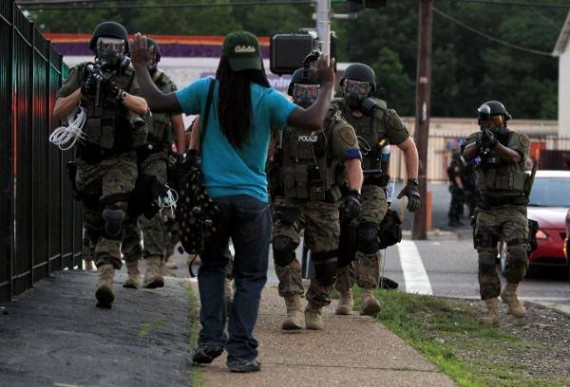
President Obama will be making changes to the program that allows surplus military equipment to be sold, or even given without cost, to local law enforcement agencies:
WASHINGTON — President Obama on Monday will ban the federal provision of some types of military-style equipment to local police departments and sharply restrict the availability of others, administration officials said.
The ban is part of Mr. Obama’s push to ease tensions between law enforcement and minority communities in reaction to the crises in Baltimore; Ferguson, Mo.; and other cities.
He is taking the action after a task force he created in January decided that police departments should be barred from using federal funds to acquire items that include tracked armored vehicles, the highest-caliber firearms and ammunition, and camouflage uniforms. The ban is part of a series of steps the president has made to try to build trust between law enforcement organizations and the citizens they are charged with protecting.
He is taking the action after a task force he created in January decided that police departments should be barred from using federal funds to acquire items that include tracked armored vehicles, the highest-caliber firearms and ammunition, and camouflage uniforms. The ban is part of a series of steps the president has made to try to build trust between law enforcement organizations and the citizens they are charged with protecting.
Mr. Obama is expected to hold up Camden as a counterpoint to places like Ferguson, where the killing of a young black man by a white police officer last summer and the violent protests that followed exposed long-simmering hostility between law enforcement agencies and minorities in cities around the country.
The trip and the action on military-style equipment are to coincide with the release on Monday of a report from a policing task force that Mr. Obama formed late last year in response to the crisis in Ferguson. The 116-page report calls for law enforcement agencies to “embrace a guardian — rather than a warrior — mind-set to build trust and legitimacy both within agencies and with the public.” It contains dozens of recommendations for agencies throughout the country.
“We are, without a doubt, sitting at a defining moment in American policing,” Ronald L. Davis, the director of the Office of Community Oriented Policing Services at the Department of Justice, told reporters in a conference call organized by the White House. “We have a unique opportunity to redefine policing in our democracy, to ensure that public safety becomes more than the absence of crime, but it must also include a presence for justice.”
After the terrorist attacks of Sept. 11, 2001, the federal government sharply expanded its efforts to provide police departments with automatic weapons, armored vehicles and other military-style gear through grant programs at the Homeland Security and Justice Departments and transfers from the Defense Department. The programs have enjoyed widespread popularity among lawmakers eager to take steps to protect their communities and constantly in search of ways to steer federal money to their districts and states.
The report from the task force on military equipment cited the police response to the Ferguson unrest as an example of how the “militarization” of police departments can lead to fear and mistrust. In addition to prohibiting some equipment outright, officials said, Mr. Obama accepted the group’s recommendation to impose new restrictions on other military-style items, such as wheeled armored vehicles, pyrotechnics, battering rams and riot gear, and more stringent requirements for training and information collection for departments that acquire them.
Mr. Obama is expected to hold up Camden as a counterpoint to places like Ferguson, where the killing of a young black man by a white police officer last summer and the violent protests that followed exposed long-simmering hostility between law enforcement agencies and minorities in cities around the country.
The trip and the action on military-style equipment are to coincide with the release on Monday of a report from a policing task force that Mr. Obama formed late last year in response to the crisis in Ferguson. The 116-page report calls for law enforcement agencies to “embrace a guardian — rather than a warrior — mind-set to build trust and legitimacy both within agencies and with the public.” It contains dozens of recommendations for agencies throughout the country.
“We are, without a doubt, sitting at a defining moment in American policing,” Ronald L. Davis, the director of the Office of Community Oriented Policing Services at the Department of Justice, told reporters in a conference call organized by the White House. “We have a unique opportunity to redefine policing in our democracy, to ensure that public safety becomes more than the absence of crime, but it must also include a presence for justice.”
After the terrorist attacks of Sept. 11, 2001, the federal government sharply expanded its efforts to provide police departments with automatic weapons, armored vehicles and other military-style gear through grant programs at the Homeland Security and Justice Departments and transfers from the Defense Department. The programs have enjoyed widespread popularity among lawmakers eager to take steps to protect their communities and constantly in search of ways to steer federal money to their districts and states.
The report from the task force on military equipment cited the police response to the Ferguson unrest as an example of how the “militarization” of police departments can lead to fear and mistrust. In addition to prohibiting some equipment outright, officials said, Mr. Obama accepted the group’s recommendation to impose new restrictions on other military-style items, such as wheeled armored vehicles, pyrotechnics, battering rams and riot gear, and more stringent requirements for training and information collection for departments that acquire them.
The issue of police militarization is not new, of course. To some degree, it is a phenomenon that goes back a decade or more and has its root in the increasingly belligerent stance that law enforcement agencies at all levels took to the War On Drugs and, in some cities, the rise in gang activity that was fueled by the illegal drug trade. In some respects, there were parts of the movement that made some sense given the fact that police agencies were often finding themselves seriously outgunned by drug gangs that regularly carried semi-automatic, and in some cases fully automatic, weaponry. Things really moved into high gear, though, after the September 11th attacks as law enforcement agencies across the country sought Federal assistance in preparing for terrorist attacks regardless of whether or not there was a likelihood that their jurisdictions were considered to be likely targets of terrorism. Additionally, of course, the military campaigns in Iraq and Afghanistan resulted in a large amount of surplus military gear that the Federal Government decided to transfer to local law enforcement for their use and, of course, the local authorities took up the Federal Government on its offer.
Every so often, reports would surface about police using military tactics and equipment in the course of what would otherwise have been normal law enforcement activities. There would be reports, for example, of innocent people shot to death in the midst of a no knock raid on what turned out to be the wrong address, families terrorized by police in military gear holding them and their children at gun point, and family pets shot to death for no good reason. It wasn’t until the events in Ferguson, Missouri, though, that the issue of police militarization really entered the public consciousness. The sight of police in military gear, and riding what had once served as a military transport, on the streets of an American city was something that seemed to resonate quite strongly with the American public regardless of race, and it was that reaction that led in part to the review that President Obama ordered.
Radley Balko, who wrote the highly recommended Rise Of The Warrior Cop: The Militarization Of America’s Police Forces and has been otherwise writing about this issue for several years, makes some positive comments about the changes the President is announcing today, but also warns that they don’t go far enough in addressing the problem:
This announcement is significant. There are types of objections to how the 1033 Program affects police militarization in America. The first is a practical objection — this equipment was designed for use on the battlefield. There’s just no appropriate domestic application for a tracked tank or for guns that shoot .50-caliber ammunition.
The second objection is more about mindset, symbolism and the kind of society in which we want to live. There are plenty of scenarios under which a police department would legitimately need a bulletproof truck. But there’s really no reason why that truck needs to be an MRAP, or painted camouflage or military green, or designed to look as imposing and intimidating as possible. Imagery is important. It’s an indication of how the police see themselves, how they see the community they serve and how the perceive their relationship with that community. And all of that in turn affects how the community views the police. It isn’t difficult to understand how a cop who is dressed in camouflage who rides around the neighborhood in an MRAP is likely to approach to his job with a different mindset than a cop in traditional police blues who conducts daily foot patrols in the same neighborhood.
From what has been reported, this new initiative addresses these concerns as well and seems to indicate that the Obama administration understands and appreciates that the symbolic component of police militarization is just as important as the practical component. I’m uncomfortable with any military vehicles going to local police. Free societies tend to draw a clear line between cops and soldiers. Blurring that line indicates a failure to appreciate its importance. But this initiative is moving toward reestablishing that line, not moving it or further blurring it. Federal programs are pretty difficult to disband, so a blanket ban was probably never in the cards. Conditioning the acceptance of this gear on increased transparency, accountability and a move toward community policing seems like a good compromise. We’ll either get less use of this military-issued equipment, or we’ll get more and better information about how it’s used. Either outcome is progress.
(…)
Now for the bad news.
There’s no understating the role the 1033 Program played in militarizing U.S. police forces. Though it was codified in the 1990s, the transfer policy existed informally dating back to the early 1980s. So reining it in is important. It sends a clear message that the administration really gets this issue.
That said, most of the militarization today happens outside the 1033 Program. As the Heritage Foundation reported last year, few of the weapons we saw in those iconic images coming out of Ferguson were obtained through 1033. That program created the thirst for militarization, but police agencies can now quench that thirst elsewhere. Since 2003, for example, the Department of Homeland Security has been giving grants to police departments around the country to purchase new military-grade gear. That program now dwarfs the 1033 Program. It has also given rise to a cottage industry of companies that build gear in exchange for those DHS checks. Those companies now have a significant lobbying presence in Washington. I suspect that presence will now only grow stronger. So if the Obama administration really wants to roll back police militarization, this program needs reform, too.
Police agencies also sometimes buy the gear directly from manufacturers. Some purchase gear through donations. In some cases, even individual officers buy their own stuff. There really isn’t much the Obama administration can do about these sources of militarized weapons.
Ultimately, I think going after the symbolism component to militarization is more important than attacking the the practical component. Most police departments are always going to have a SWAT team. Larger departments will have several. So the option to use militarized force will always be available. The key is to get them to opt for it only when it’s appropriate. (A good start would be to remove the incentives to use such force when it isn’t.) Or better yet, to instill a healthy reluctance to use such force at all — to make deescalating conflicts the priority instead of overwhelming them.
The good news is that this new policy suggests that the Obama administration understands this.
As Balko argues in his book, the militarization of police is about a lot much than just the type of equipment that they have access to. That is certainly a part of it, of course, since having access to military-style equipment makes it more likely that police commanders will resort to its use in a given situation rather than exploring other alternatives. The problem is rooted as much in how police are trained and the attitudes with which they approach members of the public as it does in the type of equipment they use. As we’ve seen, even police officers armed with standard police equipment can have a deadly impact for the wrong reasons. The role that militarization plays in all of this is that it essentially creates an attitude where police become trained to view the general public as an adversary in the same way that the solider on the battlefield does. While this may be a smart attitude for an officer to have in specific situations, or even in certain dangerous neighborhoods of a given city, it’s an unhealthy way for police to view a large segment of the public as a whole. Ultimately, it leads to the kinds of problems we’ve seen in Ferguson, Cleveland, South Carolina, Baltimore, just in the past year.
Changing these attitudes won’t be accomplished simply by cutting back on the ability of local law enforcement to arm themselves to the teeth with equipment better left to soldiers. That’s certainly a significant part of it, of course, and I agree with Balko that something ought to be done about the Department of Homeland Security program and other ways that the Federal Government assists local law enforcement in acquiring this type of equipment, In the end, though, what’s really needed is a change in the mentality of law enforcement. To some degree, perhaps, that will happen if they no longer have easy access to this type of equipment, but that’s only part of what needs to change. We also need to think about how training is conducted in police academies across the country, and what kind of training police officers get once they are already on the force. What the President is announcing here isn’t a cure all for these problems, but it’s a good first step.
Here’s the report of the President’s Law Enforcement Equipment Working Group:
Law Enforcement Equipment Working Group Final Report by Doug Mataconis

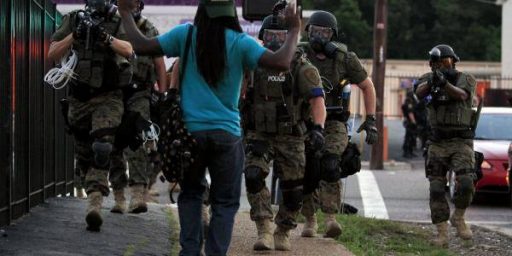
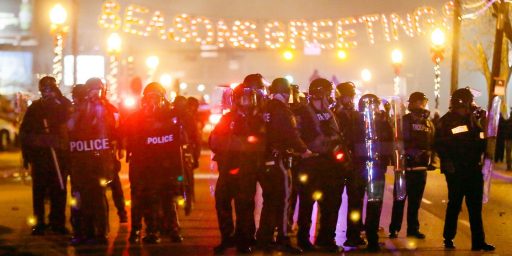
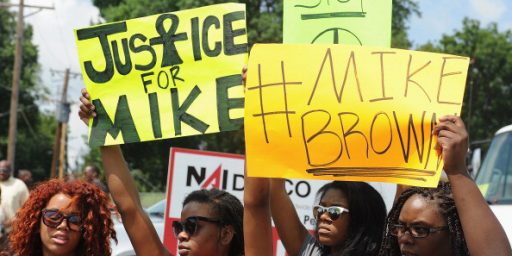
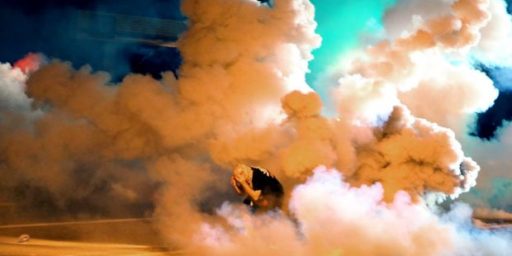
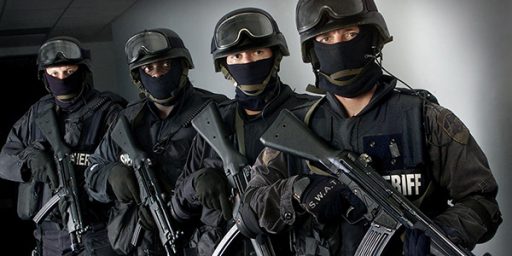
I’ve got Balko’s book: good stuff, if not infuriating. But anyway, if he considers it a small step in the right direction, then I’ll give Obama some credit here.
Good. It’s a good start.
The militarization of the police force was supposed to be in preparation for fighting terrorism.
Sadly, some domestic police forces seems to have a problem distinguishing between terrorism and jay walking.
Can we move to take away their toys from them as well?
It’s about time. Stevie Wonder could have seen that supplying police forces with military weapons would mean citizens with tin badges would treat citizens without tin badges like the enemy.
But there are areas where the police will need the necessary weapons, technology, and resources in combating gangs, organized crime (Mafia), drug pushers, bank robbers, rioters, and the threat of terrorists just across the border. Some of these groups are using military grade weapons. And look at the carnage the other day when police found themselves in a pitched battle with several motorcycle gangs. In most cases the police can still be equipped with traditional and “normal” gear: cuffs, night stick, mace, handgun, and walkie talkie.
It is time for new, safe technology to be developed and used. One promising device in the works throws out a type of web that sticks to a suspect and bounds them from moving. Another is a small light “cannon” that emits a light so intense that it will temporarily blind a criminal for several minutes – long enough for police to cuff them. These and other new devices provide apprehension that is safe to the criminals, police, and public.
Let’s keep in mind that the criminals, thugs, and hot shots do not care about Obama’s new rules; they will keep using their M40’s, M24’s, Barretts, C14’s and other high powered weapons.
Wait a second. Are Doug and Jack actually praising Obama for something? I’m looking outside my window for flying pigs, and monitoring the news for reports of hell freezing over!
Oh well, gentlemen,thank you for visiting the “dark side,” even momentarily. Kudos for when kudos are due.
Good article, Doug. I know that you and most of the commenters here (including myself) don’t agree on much, but I’m glad that we find ourselves on common ground here. When people from quite different political positions and geographic locations agree on an issue of this importance, there is some hope for progress.
Since the craziness of the Jade Helm 15 conspiracy theorists has now reached my home on the Mississippi Gulf Coast, I wonder how long before one of these whack jobs concludes that Obama is disarming local police to facilitate martial law? It shouldn’t take very long.
Sounds like President Obama may have pulled the plug too soon: “Biker gangs heading to Texas, Police Warned”. As if ISIS, Iran, North Korea, and Russia were not enough. Now he has a motorcycle gang war on his hands and a major Texas city is in the middle. Attorney General Holder needs to get down there at once; this is on his watch. Governor Perry, you need to get in there too. Get the National Guard and seal the state lines: no biker gang members allowed. And round up the ones already there: arrest them, deport them, or whatever; just get rid of them. What are you going to do, Governor ? You have a motorcickle gang taking over one of your cities. Time to act “presidential”.
“These are our choppers, Charlie” “And this is my gun, Clyde !” (Clint Eastwood shuts down a biker gang in “The Gauntlet”
See “The Gauntlet: Clint Eastwood rousting the bikers” you tube, one of the most iconic scenes in movie history, hilarious.
@Tyrell: self correction: I just remembered that AG Holder has left – he got out of Dodge just in time. So now it’s up to Attorney General Lynch to go down there and kick some biker a_ _ ! From what I read in her biography I don’t think she would be
intimidated !
“Do you feel lucky, punk ? Well, do you?” ( Clint Eastwood , “Dirty Harry”)
@Tyrell: I can never tell if you’re a Poe or not, but I think this comment proves you aren’t. Correct Holder is gone, but so is Perry. Abbot is the Gov of the fair state of Texas now. What are you going to arrest bike gang members on? They have constitutional protections and unless they are committing a crime they can’t just be arrested for belonging to a gang. Seal the borders?
This just proves there’s an inherent problem with violent crime in the white community. Where are the fathers of these white men? They should’ve been raised better. Until the white community addresses their biker gang culture and the white on white violence affecting our Texas cities they’ll never advance as a people. Where were all the good law abiding people with guns to stop this? This was Texas after all they had to be ready.
I have previously stated on this site that my childhood occurred in Berlin before the wall. The cops on the west side wore circa 1910 uniforms, and their weapons were out of sight. The Vopos (VolksPolizei, i.e. Peoples’ Police) on the east side wore black unis, and their weapons were quite visible. The VoPos often brandished the PPSh submachine gun.
Appearance makes a difference. Tools change your thinking. I prefer living in the West to a intimidation state.
@Rob Prather: Oh, the martial law thing came up back in March. Now its the WalMart closings – to be used as “operations or detention ” center. WalMart closing those stores just fed the fire. This fall after all this fades out they will say this was just a “run up”, a practice for the real thing that will be at some undetermined time.
@Tyrell: yep, that’s the thing with conspiracy theorists: everything confirms the theory given enough time.
@Rob Prather: I know I’m replying to myself, but this didn’t take long “Allen West’s Blog Ties Obama’s Police Equipment Order To Texas Takeover”.